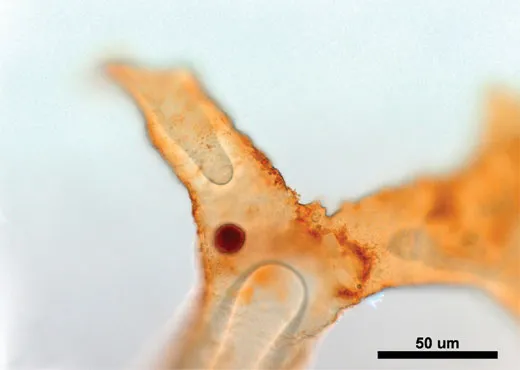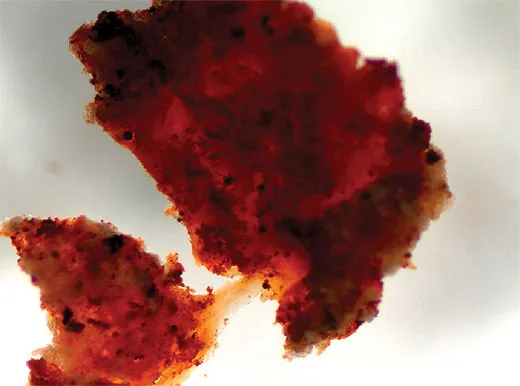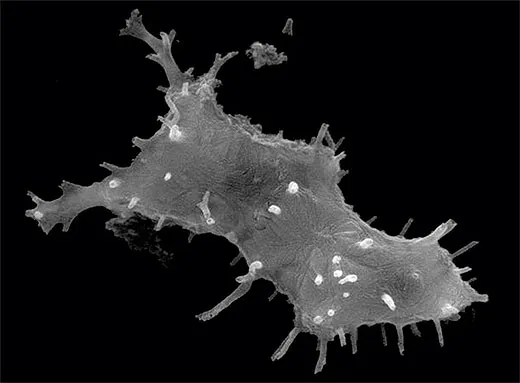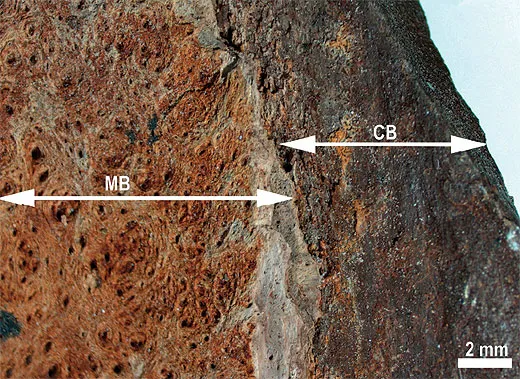Dinosaur Shocker
Probing a 68-million-year-old T. rex, Mary Schweitzer stumbled upon astonishing signs of life that may radically change our view of the ancient beasts
Neatly dressed in blue Capri pants and a sleeveless top, long hair flowing over her bare shoulders, Mary Schweitzer sits at a microscope in a dim lab, her face lit only by a glowing computer screen showing a network of thin, branching vessels. That’s right, blood vessels. From a dinosaur. “Ho-ho-ho, I am excite-e-e-e-d,” she chuckles. “I am, like, really excited.”
After 68 million years in the ground, a Tyrannosaurus rex found in Montana was dug up, its leg bone was broken in pieces, and fragments were dissolved in acid in Schweitzer’s laboratory at North Carolina State University in Raleigh. “Cool beans,” she says, looking at the image on the screen.
It was big news indeed last year when Schweitzer announced she had discovered blood vessels and structures that looked like whole cells inside that T. rex bone—the first observation of its kind. The finding amazed colleagues, who had never imagined that even a trace of still-soft dinosaur tissue could survive. After all, as any textbook will tell you, when an animal dies, soft tissues such as blood vessels, muscle and skin decay and disappear over time, while hard tissues like bone may gradually acquire minerals from the environment and become fossils. Schweitzer, one of the first scientists to use the tools of modern cell biology to study dinosaurs, has upended the conventional wisdom by showing that some rock-hard fossils tens of millions of years old may have remnants of soft tissues hidden away in their interiors. “The reason it hasn’t been discovered before is no right-thinking paleontologist would do what Mary did with her specimens. We don’t go to all this effort to dig this stuff out of the ground to then destroy it in acid,” says dinosaur paleontologist Thomas Holtz Jr., of the University of Maryland. “It’s great science.” The observations could shed new light on how dinosaurs evolved and how their muscles and blood vessels worked. And the new findings might help settle a long-running debate about whether dinosaurs were warmblooded, coldblooded—or both.
Meanwhile, Schweitzer’s research has been hijacked by “young earth” creationists, who insist that dinosaur soft tissue couldn’t possibly survive millions of years. They claim her discoveries support their belief, based on their interpretation of Genesis, that the earth is only a few thousand years old. Of course, it’s not unusual for a paleontologist to differ with creationists. But when creationists misrepresent Schweitzer’s data, she takes it personally: she describes herself as “a complete and total Christian.” On a shelf in her office is a plaque bearing an Old Testament verse: “For I know the plans I have for you,” declares the Lord, “plans to prosper you and not to harm you, plans to give you hope and a future.”
It may be that Schweitzer’s unorthodox approach to paleontology can be traced to her roundabout career path. Growing up in Helena, Montana, she went through a phase when, like many kids, she was fascinated by dinosaurs. In fact, at age 5 she announced she was going to be a paleontologist. But first she got a college degree in communicative disorders, married, had three children and briefly taught remedial biology to high schoolers. In 1989, a dozen years after she graduated from college, she sat in on a class at Montana State University taught by paleontologist Jack Horner, of the Museum of the Rockies, now an affiliate of the Smithsonian Institution. The lectures reignited her passion for dinosaurs. Soon after, she talked her way into a volunteer position in Horner’s lab and began to pursue a doctorate in paleontology.
She initially thought she would study how the microscopic structure of dinosaur bones differs depending on how much the animal weighs. But then came the incident with the red spots.
In 1991, Schweitzer was trying to study thin slices of bones from a 65-million-year-old T. rex. She was having a hard time getting the slices to stick to a glass slide, so she sought help from a molecular biologist at the university. The biologist, Gayle Callis, happened to take the slides to a veterinary conference, where she set up the ancient samples for others to look at. One of the vets went up to Callis and said, “Do you know you have red blood cells in that bone?” Sure enough, under a microscope, it appeared that the bone was filled with red disks. Later, Schweitzer recalls, “I looked at this and I looked at this and I thought, this can’t be. Red blood cells don’t preserve.”
Schweitzer showed the slide to Horner. “When she first found the red-blood-cell-looking structures, I said, Yep, that’s what they look like,” her mentor recalls. He thought it was possible they were red blood cells, but he gave her some advice: “Now see if you can find some evidence to show that that’s not what they are.”
What she found instead was evidence of heme in the bones—additional support for the idea that they were red blood cells. Heme is a part of hemoglobin, the protein that carries oxygen in the blood and gives red blood cells their color. “It got me real curious as to exceptional preservation,” she says. If particles of that one dinosaur were able to hang around for 65 million years, maybe the textbooks were wrong about fossilization.
Schweitzer tends to be self-deprecating, claiming to be hopeless at computers, lab work and talking to strangers. But colleagues admire her, saying she’s determined and hard-working and has mastered a number of complex laboratory techniques that are beyond the skills of most paleontologists. And asking unusual questions took a lot of nerve. “If you point her in a direction and say, don’t go that way, she’s the kind of person who’ll say, Why?—and she goes and tests it herself,” says Gregory Erickson, a paleobiologist at Florida State University. Schweitzer takes risks, says Karen Chin, a University of Colorado paleontologist. “It could be a big payoff or it could just be kind of a ho-hum research project.”
In 2000, Bob Harmon, a field crew chief from the Museum of the Rockies, was eating his lunch in a remote Montana canyon when he looked up and saw a bone sticking out of a rock wall. That bone turned out to be part of what may be the best preserved T. rex in the world. Over the next three summers, workers chipped away at the dinosaur, gradually removing it from the cliff face. They called it B. rex in Harmon’s honor and nicknamed it Bob. In 2001, they encased a section of the dinosaur and the surrounding dirt in plaster to protect it. The package weighed more than 2,000 pounds, which turned out to be just above their helicopter’s capacity, so they split it in half. One of B. rex’s leg bones was broken into two big pieces and several fragments—just what Schweitzer needed for her micro-scale explorations.
It turned out Bob had been misnamed. “It’s a girl and she’s pregnant,” Schweitzer recalls telling her lab technician when she looked at the fragments. On the hollow inside surface of the femur, Schweitzer had found scraps of bone that gave a surprising amount of information about the dinosaur that made them. Bones may seem as steady as stone, but they’re actually constantly in flux. Pregnant women use calcium from their bones to build the skeleton of a developing fetus. Before female birds start to lay eggs, they form a calcium-rich structure called medullary bone on the inside of their leg and other bones; they draw on it during the breeding season to make eggshells. Schweitzer had studied birds, so she knew about medullary bone, and that’s what she figured she was seeing in that T. rex specimen.
Most paleontologists now agree that birds are the dinosaurs’ closest living relatives. In fact, they say that birds are dinosaurs—colorful, incredibly diverse, cute little feathered dinosaurs. The theropod of the Jurassic forests lives on in the goldfinch visiting the backyard feeder, the toucans of the tropics and the ostriches loping across the African savanna.
To understand her dinosaur bone, Schweitzer turned to two of the most primitive living birds: ostriches and emus. In the summer of 2004, she asked several ostrich breeders for female bones. A farmer called, months later. “Y’all still need that lady ostrich?” The dead bird had been in the farmer’s backhoe bucket for several days in the North Carolina heat. Schweitzer and two colleagues collected a leg from the fragrant carcass and drove it back to Raleigh.
As far as anyone can tell, Schweitzer was right: Bob the dinosaur really did have a store of medullary bone when she died. A paper published in Science last June presents microscope pictures of medullary bone from ostrich and emu side by side with dinosaur bone, showing near-identical features.
In the course of testing a B. rex bone fragment further, Schweitzer asked her lab technician, Jennifer Wittmeyer, to put it in weak acid, which slowly dissolves bone, including fossilized bone—but not soft tissues. One Friday night in January 2004, Wittmeyer was in the lab as usual. She took out a fossil chip that had been in the acid for three days and put it under the microscope to take a picture. “[The chip] was curved so much, I couldn’t get it in focus,” Wittmeyer recalls. She used forceps to flatten it. “My forceps kind of sunk into it, made a little indentation and it curled back up. I was like, stop it!” Finally, through her irritation, she realized what she had: a fragment of dinosaur soft tissue left behind when the mineral bone around it had dissolved. Suddenly Schweitzer and Wittmeyer were dealing with something no one else had ever seen. For a couple of weeks, Wittmeyer said, it was like Christmas every day.
In the lab, Wittmeyer now takes out a dish with six compartments, each holding a little brown dab of tissue in clear liquid, and puts it under the microscope lens. Inside each specimen is a fine network of almost-clear branching vessels—the tissue of a female Tyrannosaurus rex that strode through the forests 68 million years ago, preparing to lay eggs. Close up, the blood vessels from that T. rex and her ostrich cousins look remarkably alike. Inside the dinosaur vessels are things Schweitzer diplomatically calls “round microstructures” in the journal article, out of an abundance of scientific caution, but they are red and round, and she and other scientists suspect that they are red blood cells.
Of course, what everyone wants to know is whether DNA might be lurking in that tissue. Wittmeyer, from much experience with the press since the discovery, calls this “the awful question”—whether Schweitzer’s work is paving the road to a real-life version of science fiction’s Jurassic Park, where dinosaurs were regenerated from DNA preserved in amber. But DNA, which carries the genetic script for an animal, is a very fragile molecule. It’s also ridiculously hard to study because it is so easily contaminated with modern biological material, such as microbes or skin cells, while buried or after being dug up. Instead, Schweitzer has been testing her dinosaur tissue samples for proteins, which are a bit hardier and more readily distinguished from contaminants. Specifically, she’s been looking for collagen, elastin and hemoglobin. Collagen makes up much of the bone scaffolding, elastin is wrapped around blood vessels and hemoglobin carries oxygen inside red blood cells.
Because the chemical makeup of proteins changes through evolution, scientists can study protein sequences to learn more about how dinosaurs evolved. And because proteins do all the work in the body, studying them could someday help scientists understand dinosaur physiology—how their muscles and blood vessels worked, for example.
Proteins are much too tiny to pick out with a microscope. To look for them, Schweitzer uses antibodies, immune system molecules that recognize and bind to specific sections of proteins. Schweitzer and Wittmeyer have been using antibodies to chicken collagen, cow elastin and ostrich hemoglobin to search for similar molecules in the dinosaur tissue. At an October 2005 paleontology conference, Schweitzer presented preliminary evidence that she has detected real dinosaur proteins in her specimens.
Further discoveries in the past year have shown that the discovery of soft tissue in B. rex wasn’t just a fluke. Schweitzer and Wittmeyer have now found probable blood vessels, bone-building cells and connective tissue in another T. rex, in a theropod from Argentina and in a 300,000-year-old woolly mammoth fossil. Schweitzer’s work is “showing us we really don’t understand decay,” Holtz says. “There’s a lot of really basic stuff in nature that people just make assumptions about.”
Young-earth creationists also see Schweitzer’s work as revolutionary, but in an entirely different way. They first seized upon Schweitzer’s work after she wrote an article for the popular science magazine Earth in 1997 about possible red blood cells in her dinosaur specimens. Creation magazine claimed that Schweitzer’s research was “powerful testimony against the whole idea of dinosaurs living millions of years ago. It speaks volumes for the Bible’s account of a recent creation.”
This drives Schweitzer crazy. Geologists have established that the Hell Creek Formation, where B. rex was found, is 68 million years old, and so are the bones buried in it. She’s horrified that some Christians accuse her of hiding the true meaning of her data. “They treat you really bad,” she says. “They twist your words and they manipulate your data.” For her, science and religion represent two different ways of looking at the world; invoking the hand of God to explain natural phenomena breaks the rules of science. After all, she says, what God asks is faith, not evidence. “If you have all this evidence and proof positive that God exists, you don’t need faith. I think he kind of designed it so that we’d never be able to prove his existence. And I think that’s really cool.”
By definition, there is a lot that scientists don’t know, because the whole point of science is to explore the unknown. By being clear that scientists haven’t explained everything, Schweitzer leaves room for other explanations. “I think that we’re always wise to leave certain doors open,” she says.
But schweitzer’s interest in the long-term preservation of molecules and cells does have an otherworldly dimension: she’s collaborating with NASA scientists on the search for evidence of possible past life on Mars, Saturn’s moon Titan, and other heavenly bodies. (Scientists announced this spring, for instance, that Saturn’s tiny moon Enceladus appears to have liquid water, a probable precondition for life.)
Astrobiology is one of the wackier branches of biology, dealing in life that might or might not exist and might or might not take any recognizable form. “For almost everybody who works on NASA stuff, they are just in hog heaven, working on astrobiology questions,” Schweitzer says. Her NASA research involves using antibodies to probe for signs of life in unexpected places. “For me, it’s the means to an end. I really want to know about my dinosaurs.”
To that purpose, Schweitzer, with Wittmeyer, spends hours in front of microscopes in dark rooms. To a fourth-generation Montanan, even the relatively laid-back Raleigh area is a big city. She reminisces wistfully about scouting for field sites on horseback in Montana. “Paleontology by microscope is not that fun,” she says. “I’d much rather be out tromping around.”
“My eyeballs are just absolutely fried,” Schweitzer says after hours of gazing through the microscope’s eyepieces at glowing vessels and blobs. You could call it the price she pays for not being typical.



